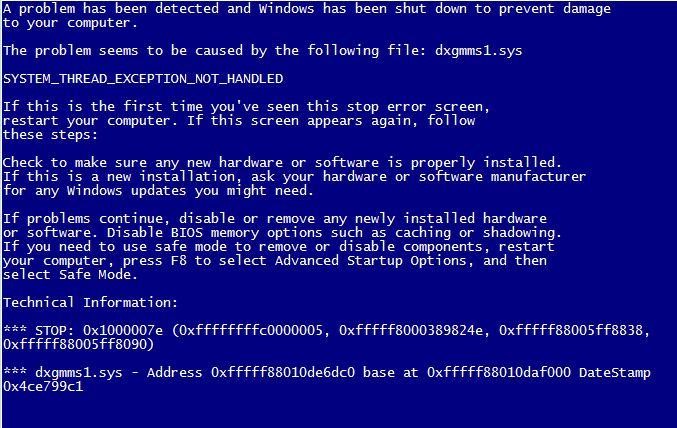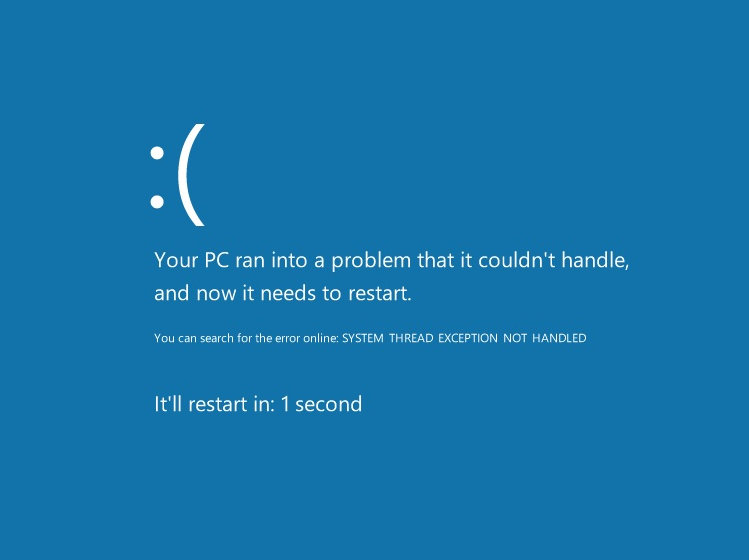| 我們致力本地化我們在盡可能多的語言的網站越好,然而這一頁是機器使用谷歌翻譯翻譯。 | 關閉 |
-
-
產品
-
資源
-
支援
-
公司
-
指南中的“系統線程異常不處理”的死亡錯誤藍屏A Guide to the “System Thread Exception Not Handled” Blue Screen of Death Error
通過 Steve Horton 四月 11, 2013Blue Screen of Death, bsod, SYSTEM_THREAD_EXCEPTION_NOT_HANDLED4 Comments錯誤名稱:SYSTEM_THREAD_EXCEPTION_NOT_HANDLED
如果您正在閱讀本文,那意味著您偶然發現了系統線程異常未處理藍屏死機錯誤。儘管有這個名字,BSoD並不像你想像的那樣糟糕 – 大部分時間都是通過簡單的重啟修復它們,但是如果你正在讀這篇文章而不是這個就一定給你帶來了麻煩。
幸運的是,我們在這裡提供幫助。在早期版本的Windows上,您的BSoD應該看起來像這樣:

在8之前的Windows版本上。但是,如果您使用的是Microsoft最新的操作系統,它應該如下所示:

在Windows 8上。什麼是SYSTEM_THREAD_EXCEPTION_NOT_HANDLED?
當系統線程生成錯誤處理程序無法捕獲的異常時,會發生SYSTEM_THREAD_EXCEPTION_NOT_HANDLED錯誤。因為這個錯誤沒有引起注意,你的計算機拋出了一些紅旗,並決定自行關閉以防止任何進一步的損害。
像大多數BSoD一樣,這個錯誤通常是由於過時的驅動程序或錯誤的程序而發生的。驅動程序允許您的計算機及其外圍設備的部件與您的主板通信,錯誤配置的驅動程序可能導致許多問題,包括BSoD。
我該如何解決這個錯誤?
此特定錯誤往往是由過時的程序引起的,例如WinRing。 ISO刻錄機軟件和處理器超頻軟件(如EVGA Precision或MSI Afterburner)也可以導致BSoD,所以一定要卸載它們。
如果在驗證您的驅動程序已更新並且您的系統是安全的有害程序後,您仍然遇到此BSoD,那麼您的操作系統本身可能需要全新安裝(如果您使用的是Windows 8)或者您您的機器內有錯誤的RAM(隨機存取存儲器)。
在嘗試重新安裝Windows之前,請務必更新BIOS並確保所有驅動程序都已獲得正確的維護。我們的Driver Reviver和Registry Reviver軟件可以幫助確保您的計算機得到適當更新,您還可以使用Windows Update和設備管理器(從控制面板訪問)自行完成這些操作。 BIOS升級程序因製造商而異,但通常在製造商的網站上有說明。
如果您已驗證系統中的所有內容都是最新的並且您仍然遇到問題,請重新安裝Windows。如果在此之後,您仍然遇到相同的問題,請聯繫技術人員或致電Microsoft或您的製造商以獲取有關故障內存或主板的支持。
Was this post helpful?YesNo把它釘在 Pinterest 上